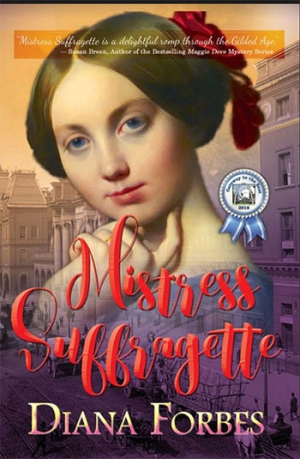Mistress Suffragette
With its mixture of contemporary gutsiness and nineteenth-century manners, this is a delightful exploration of leaving home.
Diana Forbes revisits the Gilded Age in this lively, mesmerizing historical romance. Mistress Suffragette is a deft portrayal of risky liaisons, the women’s movement, and an unlikely heroine.
Raised in the wealthy circle of Newport, Rhode Island, seventeen-year-old Penelope finds herself without marriage prospects after her father loses his fortune in the Panic of 1893. When she’s propositioned at a ball by a married financier, Edgar Daggers, her reputation hangs in the balance. Faced with the choice to accept the path others have set for her or to make her own way, she escapes to Boston, where she finds herself in the role of a public speaker for the women’s suffrage movement.
A sharp narration emphasizes Penelope’s resilience. Through a series of escapades, including life in the tenements of New York, her transformation from a reluctant debutante to a capable woman becomes a fascinating mirror for a changing society.
The plot wisely avoids a sudden about-face. True to her youthful, impulsive nature, Penelope experiences setbacks when Daggers returns to the scene. Her commitment to an offshoot of the movement that focuses on dress reform—spearheaded by her colleague Verdana, a pantaloons-wearing charismatic—also wavers between support for the idea and her desire to keep to a corseted tradition.
Much of the conflict in the book stems from the tug between Penelope’s outward activism and the fact that being lovers with a married philanderer runs counter to her newfound views on women’s independence. At times Penelope’s naiveté frustrates; she doesn’t avoid Daggers’s violence immediately. She resolves the issue in a rapid denouement that highlights her ingenuity.
Despite occasional darkness—such as an attempted assault, an effigy directed at Penelope because of her involvement in the movement, hints at industrialism’s negative effects, and poverty in the city—the book takes a lighter tack, keeping the focus on Penelope’s struggle to find the right person to love and on her new life. Early feminism provides a memorable platform for Penelope’s growth. She’s a flawed, thoroughly enjoyable protagonist who turns out to be stronger than she believes.
Secondary characters stand out against the wider drama of a sheltered, resourceful woman who gradually learns self-reliance. Penelope’s blithe mother, Mrs. Stanton, provides comic relief while revealing surprising skill in a scene that involves running down a potential suitor with a newfangled quadricycle. Formidable leader of the movement and society scion Amy Adams Buchanan Van Buren’s imposing demeanor and uncanny ability to know everything that happens around her bely a real concern for her friends. The socialist ideals of painter Stone Aldrich teach Penelope a valuable lesson.
Subtler themes on choosing one’s own family outside of one’s blood relatives and subverting expectations add dimension to the work. With its mixture of contemporary gutsiness and nineteenth-century manners, Mistress Suffragette is a delightful exploration of leaving home.
Reviewed by
Karen Rigby
Disclosure: This article is not an endorsement, but a review. The publisher of this book provided free copies of the book and paid a small fee to have their book reviewed by a professional reviewer. Foreword Reviews and Clarion Reviews make no guarantee that the publisher will receive a positive review. Foreword Magazine, Inc. is disclosing this in accordance with the Federal Trade Commission’s 16 CFR, Part 255.

